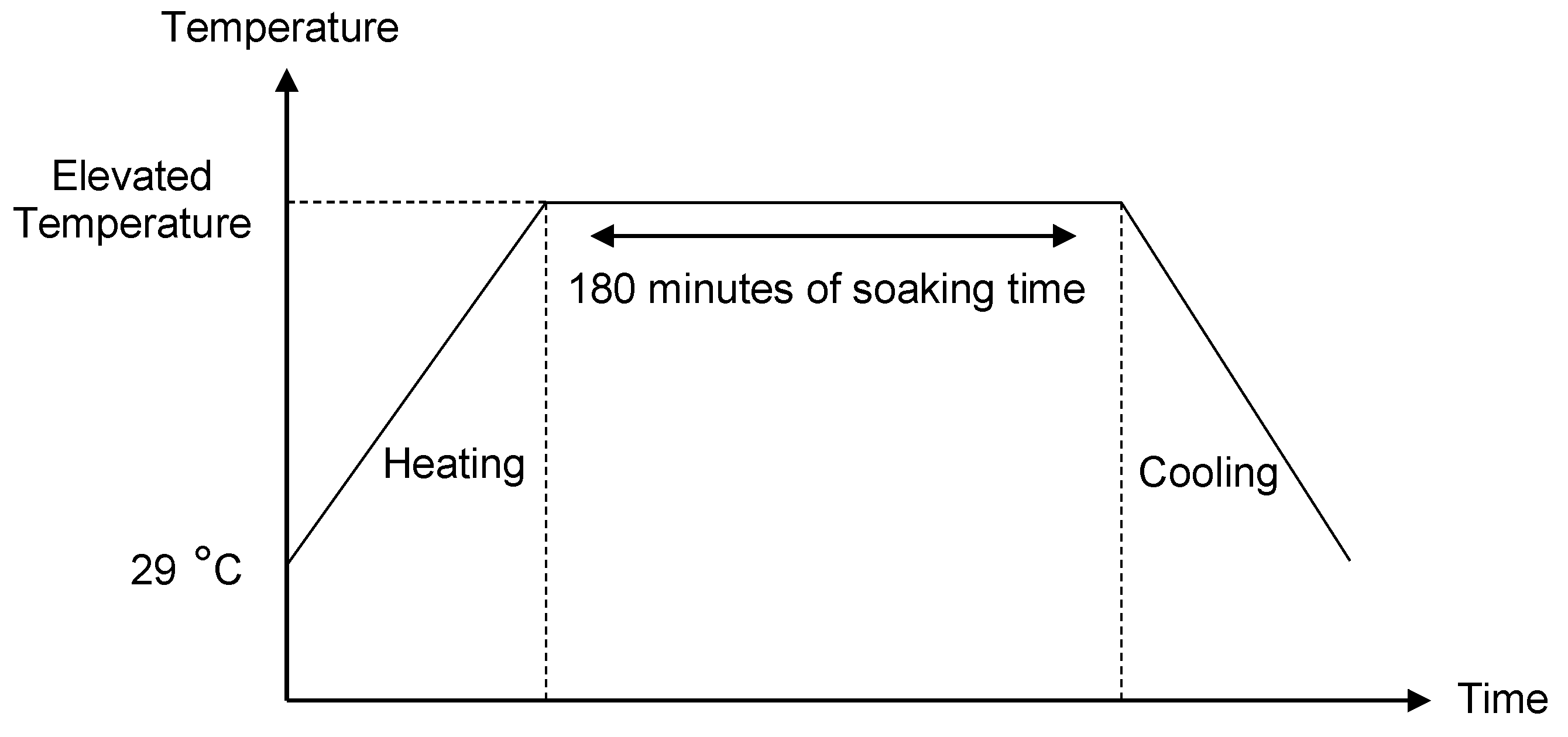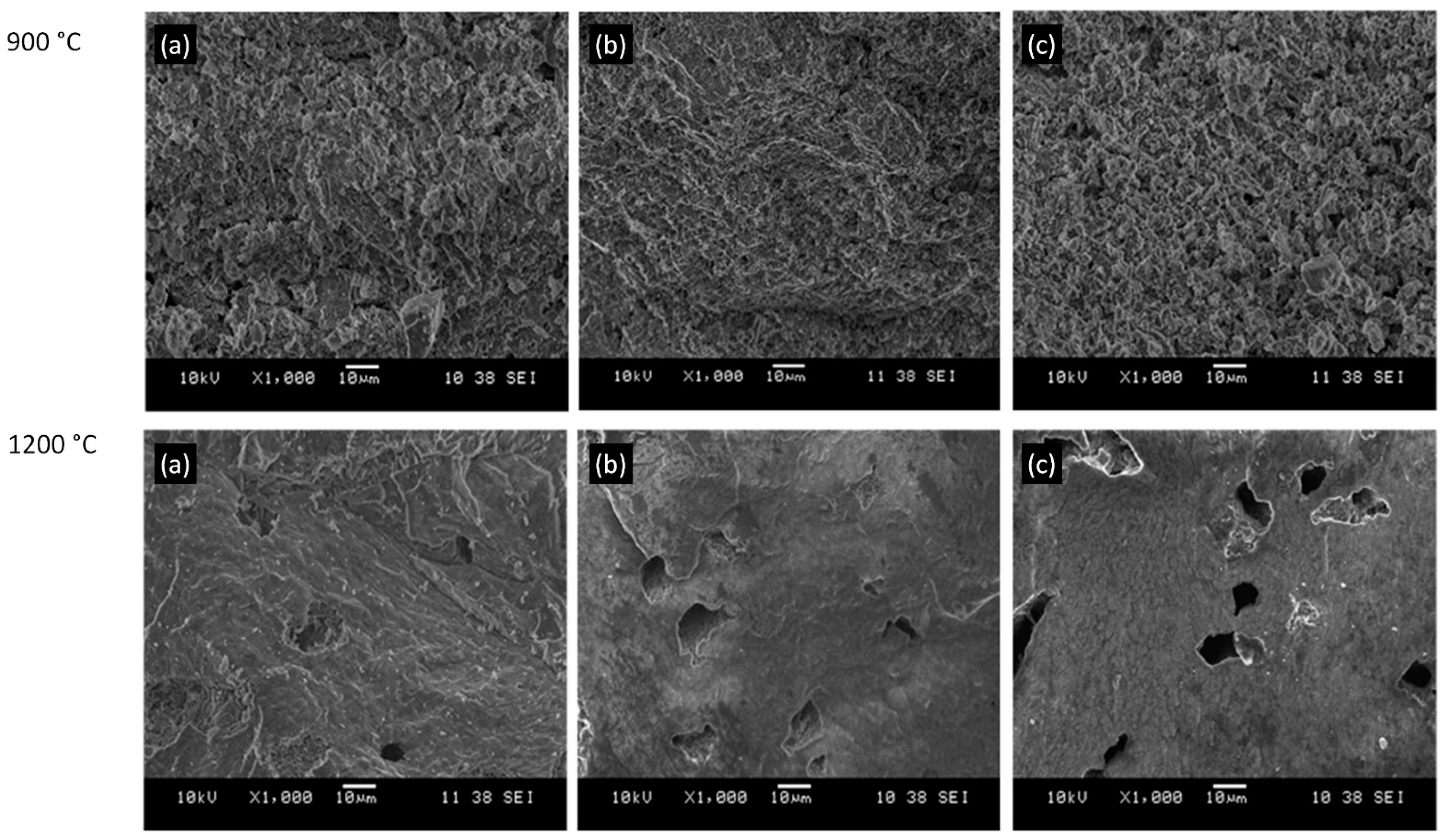Geopolymer-Based Nepheline Ceramics: Effect of Sintering Profile on Morphological Characteristics and Flexural Strength
Abstract
:1. Introduction
2. Materials and Methods
2.1. Sample Preparation and Experimentation
2.2. Investigation of Unsintered and Sintered Geopolymer
3. Results and Discussion
3.1. Microstructural Analysis
3.2. Flexural Strength
3.3. Porosity Evolution Analysis
4. Conclusions
Author Contributions
Funding
Institutional Review Board Statement
Informed Consent Statement
Data Availability Statement
Acknowledgments
Conflicts of Interest
References
- Kovářík, T.; Hájek, J.; Pola, M.; Rieger, D.; Svoboda, M.; Beneš, J.; Šutta, P.; Deshmukh, K.; Jandová, V. Cellular ceramic foam derived from potassium-based geopolymer composite: Thermal, mechanical and structural properties. Mater. Des. 2021, 198, 109355. [Google Scholar] [CrossRef]
- Zhang, Z.; Provis, J.L.; Reid, A.; Wang, H. Geopolymer foam concrete: An emerging material for sustainable construction. Constr. Build. Mater. 2014, 56, 113–127. [Google Scholar] [CrossRef]
- Davidovits, J.; Quentin, S. Geopolymers Inorganic polymerie new materials. J. Therm. Anal. 1991, 37, 1633–1656. [Google Scholar] [CrossRef]
- Khale, D.; Chaudhary, R. Mechanism of geopolymerization and factors influencing its development: A review. J. Mater. Sci. 2007, 42, 729–746. [Google Scholar] [CrossRef]
- Shi, C.; Jimenez, A.F.; Palomo, A. New cements for the 21st century: The pursuit of an alternative to Portland cement. Cem. Concr. Res. 2011, 41, 750–763. [Google Scholar] [CrossRef]
- Singh, B.; Ishwarya, G.; Gupta, M.; Bhattacharyya, S. Geopolymer concrete: A review of some recent developments. Constr. Build. Mater. 2015, 85, 78–90. [Google Scholar] [CrossRef]
- Shahedan, N.; Abdullah, M.; Mahmed, N.; Kusbiantoro, A.; Tammas-Williams, S.; Li, L.-Y.; Aziz, I.; Vizureanu, P.; Wysłocki, J.; Błoch, K.; et al. Properties of a New Insulation Material Glass Bubble in Geo-Polymer Concrete. Materials 2021, 14, 809. [Google Scholar] [CrossRef] [PubMed]
- Burduhos Nergis, D.D.; Vizureanu, P.; Corbu, O. Synthesis and Characteristics of Local Fly Ash Based Geopolymers Mixed with Natural Aggregates. Rev. Chim. 2019, 70, 1262–1267. [Google Scholar] [CrossRef]
- Azimi, E.A.; Abdullah, M.M.A.B.; Vizureanu, P.; Salleh, M.A.A.M.; Sandu, A.V.; Chaiprapa, J.; Yoriya, S.; Hussin, K.; Aziz, I.H. Strength Development and Elemental Distribution of Dolomite/Fly Ash Geopolymer Composite under Elevated Temperature. Materials 2020, 13, 1015. [Google Scholar] [CrossRef] [PubMed]
- Vizureanu, P.; Samoila, C.; Cotfas, D. MATERIALS PROCESSING USING SOLAR ENERGY. Environ. Eng. Manag. J. 2009, 8, 301–306. [Google Scholar] [CrossRef]
- Faris, M.A.; Abdullah, M.M.A.; Sandu, A.V.; Ismail, K.N.; Moga, L.M.; Neculai, O.; Muniandy, R. Assessment of Alkali Acti-vated Geopolymer Binders as an Alternative of Portlant Cement. Mater. Plast. 2017, 54, 145–154. [Google Scholar] [CrossRef]
- Nergis, D.D.B.; Vizureanu, P.; Ardelean, I.; Sandu, A.V.; Corbu, O.C.; Matei, E. Revealing the Influence of Microparticles on Geopolymers’ Synthesis and Porosity. Materials 2020, 13, 3211. [Google Scholar] [CrossRef] [PubMed]
- Zhang, Z.; Wang, K.; Mo, B.; Li, X.; Cui, X. Preparation and characterization of a reflective and heat insulative coating based on geopolymers. Energy Build. 2015, 87, 220–225. [Google Scholar] [CrossRef]
- Shahari, S.; Fathullah, M.; Abdullah, M.M.A.B.; Shayfull, Z.; Mia, M.; Darmawan, V.E.B. Recent developments in fire retardant glass fibre reinforced epoxy composite and geopolymer as a potential fire-retardant material: A review. Constr. Build. Mater. 2021, 277, 122246. [Google Scholar] [CrossRef]
- Fragassa, C. Limits In Application of International Standards to Innovative Ceramic Solutions. Int. J. Qual. Res. 2015, 9, 279–298. Available online: http://www.ijqr.net/journal/v9-n2/8.pdf (accessed on 12 May 2017).
- Peigang, H.; Jia, D. Low-temperature sintered pollucite ceramic from geopolymer precursor using synthetic metakaolin. J. Mater. Sci. 2013, 48, 1812–1818. [Google Scholar]
- Becker, M.Z.; Shomrat, N.; Tsur, Y. Recent Advances in Mechanism Research and Methods for Electric-Field-Assisted Sintering of Ceramics. Adv. Mater. 2018, 30, e1706369. [Google Scholar] [CrossRef] [PubMed]
- Rajeswari, K.; Chaitanya, S.; Biswas, P.; Suresh, M.B.; Rao, Y.S.; Johnson, R. Processing Research Binder burnout and sintering kinetic study of alumina ceramics shaped using methylcellulose. J. Ceram. Process. Res. 2015, 16, 24–31. [Google Scholar]
- Xie, N.; Bell, J.L.; Kriven, W.M. Fabrication of Structural Leucite Glass-Ceramics from Potassium-Based Geopolymer Precursors. J. Am. Ceram. Soc. 2010, 93, 2644–2649. [Google Scholar] [CrossRef]
- He, P.; Yang, Z.; Yang, J.; Duan, X.; Jia, D.; Wang, S.; Zhou, Y.; Wang, Y.; Zhang, P. Preparation of fully stabilized cubic-leucite composite through heat-treating Cs-substituted K-geopolymer composite at high temperatures. Compos. Sci. Technol. 2014, 107, 44–53. [Google Scholar] [CrossRef]
- Hu, P.; Gui, K.; Hong, W.; Zhang, X. Preparation of ZrB 2 -SiC ceramics by single-step and optimized two-step hot pressing using nanosized ZrB 2 powders. Mater. Lett. 2017, 200, 14–17. [Google Scholar] [CrossRef]
- Prado, M.O.; Fredericci, C.; Zanotto, E.D. Non-isothermal sintering with concurrent crystallization of polydispersed soda–lime–silica glass beads. J. Non-Crystalline Solids 2003, 331, 157–167. [Google Scholar] [CrossRef]
- Liew, Y.-M.; Heah, C.-Y.; Mohd Mustafa, A.B.; Kamarudin, H. Structure and properties of clay-based geopolymer cements: A review. Prog. Mater. Sci. 2016, 83, 595–629. [Google Scholar] [CrossRef]
- Dai, Y.; Yin, Y.; Xu, X.; Jin, S.; Li, Y.; Harmuth, H. Effect of the phase transformation on fracture behaviour of fused silica refractories. J. Eur. Ceram. Soc. 2018, 38, 5601–5609. [Google Scholar] [CrossRef]
- He, R.; Dai, N.; Wang, Z. Thermal and Mechanical Properties of Geopolymers Exposed to High Temperature: A Literature Review. Adv. Civ. Eng. 2020, 2020, 1–17. [Google Scholar] [CrossRef]
- Kim, B.-N.; Hiraga, K.; Morita, K.; Yoshida, H. Effects of heating rate on microstructure and transparency of spark-plasma-sintered alumina. J. Eur. Ceram. Soc. 2009, 29, 323–327. [Google Scholar] [CrossRef]
- Gunnewiek, R.F.; Kiminami, R.H. Effect of heating rate on microwave sintering of nanocrystalline zinc oxide. Ceram. Int. 2014, 40, 10667–10675. [Google Scholar] [CrossRef]
- Nazari, A.; Bagheri, A.; Sanjayan, J.; Dao, M.; Mallawa, C.; Zannis, P.; Zumbo, S. Thermal shock reactions of Ordinary Portland cement and geopolymer concrete: Microstructural and mechanical investigation. Constr. Build. Mater. 2018, 196, 492–498. [Google Scholar] [CrossRef]






| Element | Wt. (%) |
|---|---|
| Silicon Oxide (SiO2) | 54.0 |
| Aluminum Oxide (Al2O3) | 31.7 |
| Iron (II) Oxide (Fe2O3) | 4.89 |
| Potassium Oxide (K2O) | 6.05 |
| Titanium Dioxide (TiO2) | 1.41 |
| Manganese Oxide (MnO2) | 0.11 |
| Zirconium Oxide (ZrO2) | 0.10 |
| LOI | 1.74 |
Publisher’s Note: MDPI stays neutral with regard to jurisdictional claims in published maps and institutional affiliations. |
© 2022 by the authors. Licensee MDPI, Basel, Switzerland. This article is an open access article distributed under the terms and conditions of the Creative Commons Attribution (CC BY) license (https://creativecommons.org/licenses/by/4.0/).
Share and Cite
Ahmad, R.; Ibrahim, W.M.W.; Abdullah, M.M.A.B.; Pakawanit, P.; Vizureanu, P.; Abdullah, A.S.; Sandu, A.V.; Ahmad Zaidi, F.H. Geopolymer-Based Nepheline Ceramics: Effect of Sintering Profile on Morphological Characteristics and Flexural Strength. Crystals 2022, 12, 1313. https://doi.org/10.3390/cryst12091313
Ahmad R, Ibrahim WMW, Abdullah MMAB, Pakawanit P, Vizureanu P, Abdullah AS, Sandu AV, Ahmad Zaidi FH. Geopolymer-Based Nepheline Ceramics: Effect of Sintering Profile on Morphological Characteristics and Flexural Strength. Crystals. 2022; 12(9):1313. https://doi.org/10.3390/cryst12091313
Chicago/Turabian StyleAhmad, Romisuhani, Wan Mastura Wan Ibrahim, Mohd Mustafa Al Bakri Abdullah, Phakkhananan Pakawanit, Petrica Vizureanu, Arman Shah Abdullah, Andrei Victor Sandu, and Fakhryna Hannanee Ahmad Zaidi. 2022. "Geopolymer-Based Nepheline Ceramics: Effect of Sintering Profile on Morphological Characteristics and Flexural Strength" Crystals 12, no. 9: 1313. https://doi.org/10.3390/cryst12091313










